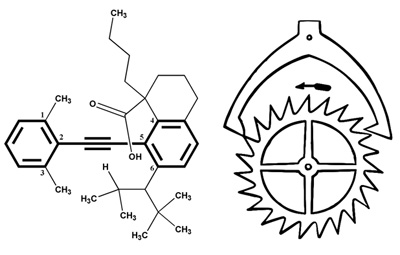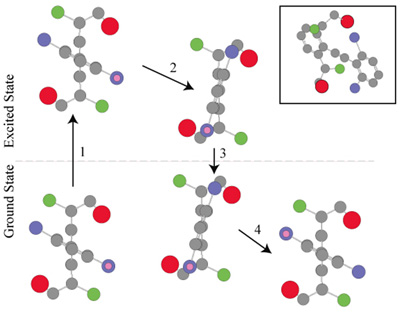Design of a light-driven molecular motor
- Photophysics of disordered organic systems.
- Development of new semiempirical methods.
- Design of dyes for imaging of biological systems.
- Design of a light-driven molecular motor.

A molecule that calculations indicate will spin when exposed to light (left), and a mechanical analogue of the chiral asymmetry that induces this spin (right).
Overview
A potentially interesting building block for nanotechnology is the molecule motor. Current approaches to the design of light-driven motors rely on photo-induced isomerizations coupled with thermalization steps. Our approach is based on a quite different phenomenon: the tendency of a conjugated system to planarize in the excited state. By adding chiral groups to a conjugated system, we have designed a molecule (above left) that computations suggest can convert this tendency towards planarization into a driving force for unidirectional rotation. The origin of the rotation is analogous the gear and escapement mechanism shown on the right above. Our motor should rotate on the ns time scale, which is orders of magnitude faster than existing motors.

Figure 1: Schematic of the photophysical processes leading to the motor rotation.
The molecule attaches chiral groups, shown above as colored spheres, to a tolane framework. One phenyl ring (the rotor) has equivalent groups, colored blue. (The pink dot is to aid in monitoring the rotation.) The other phenyl group has a green substituent that is one carbon from the phenyl ring (and dominates the steric interactions when the rotor is near the planar structure) and a red substituent that is two carbons from the phenyl ring (and dominates when the torsional angle is near 90°). In the ground electronic state, repulsion between the blue and red groups causes the ground state to have a non-planar structure with a dihedral angle somewhat larger than 90°. On optical excitation (arrow 1) the torsional barrier increases such that the rotor relaxes (arrow 2) clockwise towards the nearest planar structure. In the relaxed excited state structure, the blue group has passed the green group such that on return to the ground state (arrow 3), the rotor relaxes again in a clockwise direction. A cycle of excitation and relaxation then causes clockwise motion of 180°, back to a configuration that is equivalent to the starting point and which can now undergo another 180° rotation. The feasibility of this mechanism is supported by ab initio computations of the torsional surfaces.